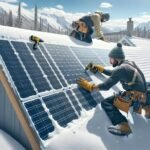Thinking about installing your own solar panels to save money? While the idea of DIY solar might seem appealing, the hidden costs can quickly add up and outweigh the initial savings. Did you know that improperly installed solar panels can lead to inefficiencies and even damage your home’s structure?
What about the complexities of exploring government incentives and rebates without professional guidance? The average installation cost for solar panels in Canada is around CAD 22,500, but the true expense of a DIY approach often includes unforeseen pitfalls. Are you prepared for the long-term risks and potential financial setbacks?
Exploring the hidden costs of DIY solar can help you make an well-informed choice that balances both your budget and your future energy needs.
Understanding DIY Solar Systems
Opting for a DIY solar system may seem appealing, but fully understanding what it entails is crucial. Did you know DIY solar panel installations can range from 4 kW to 10 kW? While that sounds efficient, let’s break down the components.
 why your neighbor’s diy solar install failed: avoid this
why your neighbor’s diy solar install failed: avoid thisDIY solar systems require precise planning and installation, starting with selecting the right solar panels. Think about this: Are you familiar with the different types of panels available? Monocrystalline panels, for example, offer high efficiency but come with a higher price tag. Polycrystalline panels are less efficient but more affordable. Which would suit your solar lifestyle better?
Components and Tools
A typical DIY solar system involves multiple components other than the solar panels. You’ll need an inverter, mounting equipment, wiring, and batteries if you plan to store energy. Have you considered the cost and compatibility of these additional components?
Don’t forget the tools. Drills, wrenches, and specialized electrical testers aren’t in every homeowner’s toolbox. Acquiring these tools represents another hidden expense.
Installation Challenges
Installing solar panels on your rooftop demands both physical energy and technical know-how. Are you comfortable climbing ladders and working at heights? More importantly, do you have experience with electrical systems? Incorrect installation can lead to inefficiencies and might even damage your roof.
Read also: why your neighbor’s diy solar install failed: avoid this
why your neighbor’s diy solar install failed: avoid this how to save thousands on your solar setup: a canadian’s guide
how to save thousands on your solar setup: a canadian’s guideIn case of structural failures or inefficiencies due to improper installation, what will you do? Fixing these issues often requires professional assistance, negating the initial savings of going DIY.
Permitting and Regulations
Exploring local permitting and regulations is another hurdle. In Canada, each province has its own requirements for solar installations. Understanding and adhering to these rules might be time-consuming. Plus, net metering details vary, affecting how much money you’ll save.
Could you benefit from professional help in this area? Companies specializing in solar panels, like Solar Panels for Life, offer expertise and can ensure everything’s compliant, often speeding up the process.
Financial Considerations
Upfront costs are just the beginning. DIY projects often overlook financing options like solar loans, which can be beneficial. Have you explored government incentives and rebates available to Canadian homeowners? These financial benefits can reduce installation costs but require thorough research to maximize savings.
Read also: why your neighbor’s diy solar install failed: avoid this
why your neighbor’s diy solar install failed: avoid this how to save thousands on your solar setup: a canadian’s guide
how to save thousands on your solar setup: a canadian’s guide avoid these common diy solar wiring mistakes in your canadian home
avoid these common diy solar wiring mistakes in your canadian homeDo you still find DIY solar attractive? Considering these hidden costs and potential pitfalls, it might be wise to consult with experts first. Explore Solar Panels for Life to get more detailed information and perhaps save yourself from unexpected expenses.
Initial Setup Costs
Deciding to install a DIY solar system is a significant choice that impacts your finances and lifestyle. The journey starts with an understanding of initial setup costs, which can be surprisingly high and complex.
Equipment and Installation
When considering equipment and installation, you must account for solar panels, inverters, racking, and possibly batteries. High-quality solar panels can cost between CAD 0.85 to CAD 1.25 per watt. For a 5 kW system, this means an initial investment of CAD 4,250 to CAD 6,250 just for the panels. But that’s not all. You’ll also need:
- Inverters: Essential for converting DC power to AC power, costing between CAD 1,000 and CAD 3,000.
- Mounting Equipment: Depending on your roof type, expect to pay CAD 500 to CAD 2,000.
- Tools: If you don’t already have them, essential tools like drills and wrenches can add CAD 200 to CAD 1,000 to your budget.
Unless you’re an expert in electrical work, hiring an electrician to handle the more technical aspects might come up as another cost, often around CAD 50 to CAD 100 per hour. Plus, don’t forget about the time and physical labor required to set everything up. Ever tried lifting and installing multiple solar panels by yourself? It’s no walk in the park.
Read also: why your neighbor’s diy solar install failed: avoid this
why your neighbor’s diy solar install failed: avoid this how to save thousands on your solar setup: a canadian’s guide
how to save thousands on your solar setup: a canadian’s guide avoid these common diy solar wiring mistakes in your canadian home
avoid these common diy solar wiring mistakes in your canadian home solar panel mounting 101: tips for canadian roofs and weather
solar panel mounting 101: tips for canadian roofs and weatherPermits and Inspections
Permits and inspections can’t be overlooked. They ensure your installation meets local regulations, which can vary widely across Canada. Permits may cost between CAD 500 and CAD 2,000. This isn’t just a one-time fee. Some regions, like Ontario and British Columbia, require multiple inspections, each adding to your total expenses.
Exploring this bureaucratic maze without professional help can also be time-consuming. Do you have the time to visit your local permitting office multiple times, fill out lengthy forms, and schedule inspections? These tasks can consume days or even weeks, costing you not just money but valuable time.
Finally, inspections by certified professionals, though necessary, could uncover compliance issues, leading to additional costs. Imagine having to modify your setup because it didn’t meet regulatory standards. That’s another wrinkle in the DIY solar lifestyle, aren’t you glad you planned for contingencies?
Considering all these hidden costs, you might wonder if professional installation could save you both time and money in the long run. To make an well-informed choice, explore comprehensive solutions on Solar Panels for Life.
Long-term Maintenance Expenses
Choosing a DIY approach to solar panel installation carries certain long-term maintenance expenses. Let’s break down what you can expect.
Regular Maintenance
You’ve set up your DIY solar panels, but now what? Regular maintenance is essential to ensure their efficiency. Solar panels need periodic cleaning, especially to remove dirt, leaves, and bird droppings that can block sunlight. While professional cleaning services can cost between CAD 150 and CAD 300 per visit, doing it yourself requires the right tools—think soft brushes, biodegradable soap, and a long hose.
Consider the time investment too. Will you clean your panels monthly or quarterly? If you reside in a region with heavy snowfall, extra maintenance costs could quickly add up during winter. Also, examining electrical connections and monitoring system performance are necessary tasks. Neglecting these can lead to reduced energy output. Is the DIY route still appealing with these consistent efforts required?
Repairs and Replacements
DIY installations might save initial costs, but what about repairs? Over time, components like inverters and batteries can fail. Replacing an inverter typically costs between CAD 1,000 and CAD 2,500. Batteries, essential for energy storage, also require replacements every 5-10 years, with costs varying from CAD 200 to CAD 1,000 per battery.
In the case of damaged solar panels, replacements can be expensive and time-consuming. If a storm hits or an accident occurs, you’d need to assess the damage, procure compatible panels, and reinstall them yourself. Plus, warranty claims might be more challenging if the manufacturer suspects improper installation. Is it worth the risk?
When weighing these hidden expenses, remember, maintaining operational efficiency is crucial for a sustainable solar lifestyle. At Solar Panels for Life, we understand these challenges and offer resources to help you manage your system effectively. Why not explore our solutions tailored to Canadian homeowners?
Potential Efficiency Issues
In your quest for energy independence, DIY solar installations may initially seem appealing. But, potential efficiency issues can detract from the expected benefits. Let’s explore these concerns in detail.
Inefficient Installations
Missed connections or improper placements can hinder your solar panels’ efficiency. DIY installations often lack the precision of professional setups. What if your solar panels are shaded for part of the day? Incorrect angling or placement can reduce energy output significantly.
Without proper alignment, even the best panels won’t reach optimal performance. You might find yourself producing less energy than anticipated, leading to a slower return on investment. Poorly installed mounting systems can cause your panels to shift or become loose over time, further reducing efficiency.
Efficiency isn’t just about energy output; it’s also about durability. Professional installers ensure that your panels withstand Canadian weather conditions for years. Skip this step, and you might face frequent adjustments or repairs, adding hidden costs to your solar lifestyle.
Poor Quality Components
Cheap components can often mean compromised efficiency. In the DIY world, it’s tempting to cut corners with low-cost options. But, low-quality solar panels and inverters often lead to frequent breakdowns. Have you considered how often you’ll need to replace them?
Low-grade inverters can convert sunlight to electricity inefficiently, resulting in lower energy production. Also, substandard mounting equipment could fail under stress, causing your entire set-up to falter.
Investing in high-quality gear initially might seem expensive but saves you in the long run. High-quality solar panels designed for durability and longevity provide consistent energy outputs and require less maintenance. By choosing premium components, you ensure your solar system remains efficient for years, supporting your commitment to a sustainable solar lifestyle.
When you navigate the DIY route, remember these potential pitfalls. Don’t skimp on quality components or proper installation techniques. Instead, learn more about reliable and efficient solar systems at Solar Panels for Life, where you can find all the information and products you need for a successful solar journey.
Financial Implications
Exploring the financial world of DIY solar installations can be daunting. While initial costs might seem manageable, hidden expenses can creep up on you.
Incentives and Rebates
In Canada, incentives and rebates can substantially offset the costs of solar panel installations. But, the process can be intricate. Did you know that missing out on a single form could cost you thousands? Federal and provincial programs offer various incentives, but the paperwork can be overwhelming.
For example, the Canada Greener Homes Grant provides substantial rebates, yet you must engage a certified energy advisor. If you manage to complete all necessary steps, you could save up to CAD 5,000. But, if you miss any documentation or procedural step, those savings might vanish.
Also, provincial programs vary. In Ontario, for instance, there’s a specific focus on helping residents go solar, while Alberta offers robust rebate options. To maximize these incentives, consider how Solar Panels for Life can help you navigate this complex terrain. Why not let the experts handle the red tape while you enjoy the benefits?
Insurance Considerations
Insurance is another financial layer you must consider. DIY solar installations might affect your home insurance policy. Have you checked how your insurer views self-installed solar panels? In some cases, insurers may refuse to cover damages if the installation isn’t performed by a certified professional.
Also, improper installations can lead to potential hazards, increasing your premiums. Let’s not forget the need for additional coverage. Depending on the installation, you may need liability insurance to cover accidents. This could add hundreds to your annual insurance costs.
By utilizing professional services, you could ensure that your insurance stays intact and costs remain manageable. At Solar Panels for Life, we emphasize partnering with certified installers to help you maintain your coverage while enjoying a sustainable, solar lifestyle. Faced with such complexities, is it worth the risk to go it alone? Sometimes expertise and peace of mind are priceless.
Regulatory Challenges
Exploring regulatory challenges is key when considering DIY solar panel installation in Canada.
Local Building Codes
Understanding local building codes is crucial for your DIY solar project. Each municipality in Canada enforces specific guidelines for solar installations. Ignoring these codes can result in fines, forced removals, or inefficiencies in your solar setup.
Building codes address structural integrity, electrical safety, and fire hazard prevention. For instance, municipal bylaws might require a specialized mounting system to withstand snow loads. Are you familiar with the mounting regulations in your area?
Failing to comply with building codes can void insurance coverage and manufacturer warranties. Let’s avoid these pitfalls, shall we? Check your local municipality’s website for detailed requirements. This will save you time and money in the long run while ensuring your Solar Panels for Life investment performs optimally.
Utility Company Requirements
Utility companies in Canada often set rules for grid-tied solar panel systems. From interconnection agreements to net metering, these requirements can be complex yet essential for seamless integration.
Are you aware that utility companies may need an inspection of your solar setup? If not, a surprise inspection can disrupt your solar lifestyle. Inspections ensure your system adheres to safety standards, protecting the grid and your home.
Some utility firms impose specific inverter requirements for solar installations. You must meet these criteria to qualify for net metering. Checking with your local utility provider can clarify these rules and streamline your installation process.
Understanding utility requirements can maximize your solar system’s efficiency and financial benefits, preventing costly errors down the line. At Solar Panels for Life, we’re here to help you navigate these complexities.
Conclusion
Before diving into a DIY solar project, it’s crucial to consider all the hidden costs and potential pitfalls. While the initial savings might be tempting, the long-term financial implications and risks to your home’s structural integrity can’t be ignored. Exploring government incentives and local regulations can be complex and time-consuming, adding to the overall expense.
Professional installation offers a level of reliability and efficiency that DIY projects often lack. Experts ensure your system is optimally placed and installed, maximizing energy output and durability. Consulting with professionals might save you both time and money in the long run, providing peace of mind and a more efficient solar solution.
